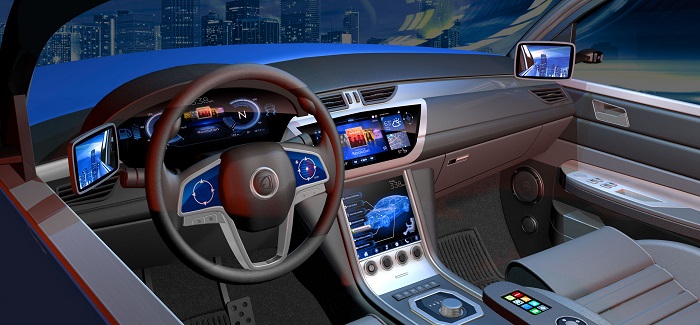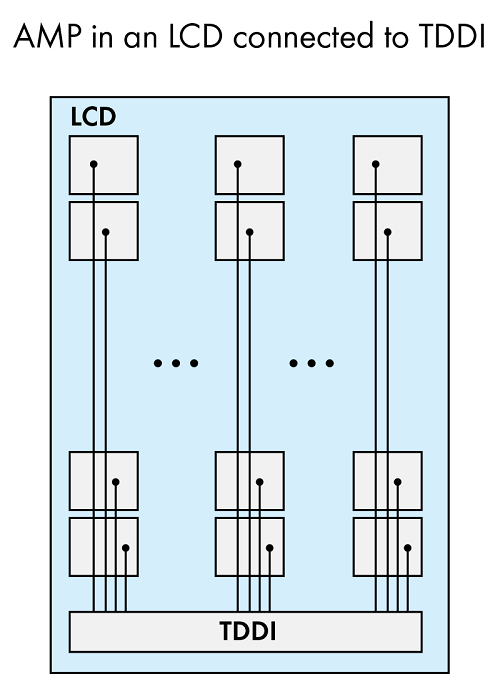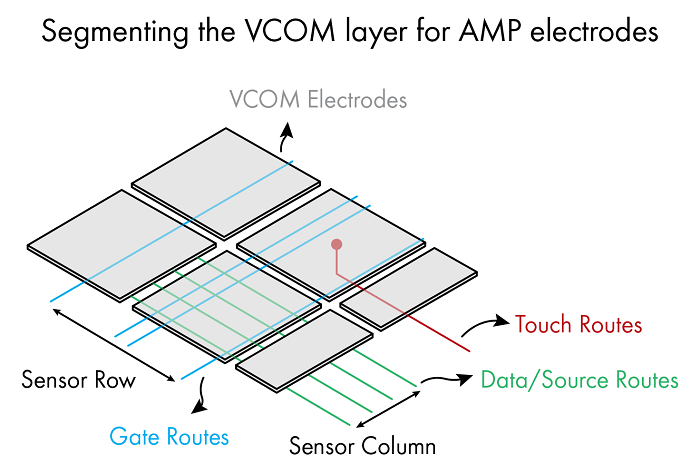By John Brady and Sunil Thomas, Synaptics
It’s been called the fourth screen — the last “unconquered” screen in our daily lives. With the average driver spending close to an hour a day in their car, how information and entertainment is served up on the road is becoming increasingly important. Factor in trends such as 5G connectivity and the potential of self-driving vehicles, and it’s no wonder the in-car display is getting more attention.
As the connected car becomes more of a reality, automakers are looking to further differentiate and enhance the user experience with bigger, brighter, and more interactive displays. Research from IHS Markit shows that the number of vehicles built in North America with display screens measuring 7 inches or more has grown by nearly 75% in the past five years, to 10.9 million from 6.3 million. European car makers are on a similar, if not faster, trajectory. IHS says that the average size of the screen also has increased, to 7.3 inches from 6.4 inches, during that period.
At the same time, consumers expect the same visual, intuitive, and tactile experience they enjoy with their mobile devices in their vehicles. This includes the ability to press, pinch, swipe, and control functions with virtual knobs. This has driven the automotive industry to look at combination touch/display solutions proven in the mobile space, where most devices now use integrated capacitance touchscreens and liquid crystal displays (LCDs) as their user interface.
The challenge in automotive is to deliver the desired performance at acceptable price points while addressing varying design needs and meeting more stringent standards than consumer devices. By combining touch and display, traditionally separate components, into a single IC, in-cell solution, automakers can lower costs but still get the user experience and form factors they need.

Fig. 1: In-vehicle displays are integrated with touch sensors into a single solution for thinner, clearer, and lower-cost screens.
TDDI combines touch sensors and display drivers in a single solution
As a result, LCD displays enabled by touch-and-display driver integration (TDDI) have emerged as the preferred option for the growing number and size of in-vehicle displays. In particular, large LCD center-stack displays that feature interactive and dynamic navigation and infotainment systems have accelerated the demand. Embedded head-rest displays, rear-view cameras, and side-view cameras, which are beginning to replace the exterior winged mirrors used in generations of vehicles, also represent opportunities for more displays.
It should be noted that organic LED (OLED) — which has garnered widespread adoption of late in mobile devices, TVs, and wearables — has not enjoyed similar success in automotive. At a recent automotive display industry event, one observer saw just a single OLED display being featured and one display supplier noted directly, “OLED is not gaining traction in automotive displays.” Although there are a couple of car models with OLEDs, cost, durability, and luminance issues are the main drawbacks to broader OLED proliferation in automotive.
Other requirements from automakers include high brightness, low sunlight reflectance, and no sensor pattern visibility, all of which are doable to varying degrees with traditional multi-component approaches. However, the automotive industry also demands a simplified supply chain, which is another factor in driving a more integrated approach.
In addition, in-vehicle display solutions must adhere to important industry standards, such as electromagnetic compatibility (EMC) that can be challenging for earlier-generation, discrete touch sensors.
TDDI solutions are commonplace in the mobile segment, with roughly 60% of the smartphone market having migrated to TDDI in just four years of being offered by Synaptics. The technology has a track record of enabling end products that are thinner, have brighter displays and borderless designs, and cost less.
Evolved for the needs of car makers, TDDI integrates the touch controller and display driver in a novel way, reducing component count and simplifying design. By moving the touch sensor from being laminated outside the LCD to embedding the sensor as part of the LCD manufacturing process, LCD makers can lower the cost substantially and improve the optical clarity at the same time.
Automotive TDDI solutions being adopted by OEMs and Tiers Ones today merge sophisticated touch and display technologies into hybrid in-cell designs, eliminating the discrete touch sensor by leveraging existing layers in the LCD. By integrating the touch sensor into the display electrodes on the thin-film transistor (TFT) glass, TDDI and full in-cell reduce the number of layers on top of the display stack-up. This simplifies the supply chain, eliminating the sensor panel supplier and the sensor lamination process. Tier Ones and OEMs can now get a fully integrated display and touch module directly from the LCD manufacturer.
Meeting the automotive industry’s requirements
The combination of touch and display technology achieved with TDDI checks all the boxes for automakers. It allows for a rich and intuitive user experience. Implementing in large displays is not an issue, as cascading techniques support various screen sizes (for example, 7- to 17-inch diagonal), aspect ratios, and HD to UHD display resolutions. Superior optical performance is achieved with synchronizing technology that eliminates display noise. Additionally, color-matching tools ensure constancy across multiple displays.
The demands on system power, complexity, and industrial design can be met with a single die and combination of the sensor into the display electrodes on glass. On top of that, variable force sensing allows an additional user input option and new UI features.
Capacitive touch has the potential to introduce noise in displays. TDDI solutions for automotive are designed to comply with the strict automotive requirements for electromagnetic interference (EMI) radiated from a display with an integrated touch sensor (ISO 11452). EMI injected into the touch sensor from radio frequency sources is also within the relevant standard’s limits (CISPR25).
Additional quality concerns are addressed through display manufacturing yield management and LCD defect detection during the LCD production’s and the vehicle’s life cycles.
Most importantly, costs can be reduced significantly compared to multiple discrete ICs, lowering costs by as much as $10 to $15/car and streamlining the supply chain. Today, 13 of the top automotive OEMs are migrating to TDDI for their in-car display needs.
Optical clarity & color enhancements
A key objective of an integrated solution for an in-vehicle touchscreen is improving the user experience — i.e., providing vivid (and consistent) colors and the highest optical clarity regardless of viewing conditions.
Features important in this regard include:
- Removing the external sensor panel leads to higher optical clarity of the display, as the touch sensor electrodes are no longer visible to the eye
- Transmittance loss of up to 10% due to the elimination of discrete sensor
- Reflectance from the additional layers with a discrete sensor and adhesive is eliminated
- Local-area auto-contrast optimization (LAACO) enables contrast control by region to optimize light and dark areas of an image simultaneously
- Sunlight readability enhancement (SRE) increases image visibility in bright sunlight with auto-adjustment of gamma for improved contrast and optimal viewing
- Independent white point adjusts color hues (RGBCMY) and white point independent of each other produces vivid images across display variations
- Support for a complete range of colors (up to a billion or more)
Using AMP to integrate touch-and-display drivers
With TDDI, a full in-cell touch sensor integrates capacitive touch sensors into an LCD’s existing structure and manufacturing technology without adding layers. It is based on the same display mask steps — providing the best optical properties.
A fully integrated in-cell architecture such as Synaptics’s AMP (Advanced Matrix Pad) allows for capacitance sensing without adding additional layers to a standard wide-viewing angle display stack-up. Typically, the Vcom electrode of an LCD panel is segmented into an array of separate touch-sensitive electrodes. The routes and via connections can be made in the same TFT metal layers as the display sources and gates. Full in-cell sensing can be achieved in a variety of processes (e.g., Si, LTPS, and IGZO) at high-display resolutions (e.g., FHD and QHD), even with TFT gates.

Fig. 2: Integrating capacitive touch sensors into an LCD’s existing structure and manufacturing technology provides the best optical properties.
In this way, the constraints of additional capacitive touch layers, connections, and routing can be removed.
In addition to the integration of the capacitive sensor with the LCD panel, additional functionality can be added with ASICs. As a result, source driver outputs and touch analog may be combined in the same chip-on glass/flex (COG/COF), as well as the combination of TCON and touch controllers in the same TDDI package.

Fig. 3: Segmenting the VCOM layer for AMP electrodes
The integration of force sensing with the display in an in-cell system removes the need for yet more components and layers to allow the thinnest, least constrained industrial designs. However, there are challenges in required assembly tolerances and operational displacements. The deflection and bending of the display panel and lens relative to the frame must be measured accurately, while the display and touch functions operate normally.
By utilizing AMP, TDDI achieves the full in-cell advantages while providing the highest signal-to-noise ratio (SNR) for touch compared to other types of in-cell, on-cell, and discrete sensors technologies. An AMP bandwidth typically ranges 100–200 kHz for touch sensing with excellent interference filtering. At the same time, an AMP uses a fraction of a display refresh time for touch sensing (for example, 5% per one full scan of the entire sensor).
Implementing the AMP in the LCD’s TFT is least disruptive of a regular LCD manufacturing process because it eliminates the need for jumpers on the TFT and the use of low-resistance material for the touch electrodes. In addition, the metal routing process is the same as the LCD source lines process.
By using the AMP structure, the capacitive coupling to each individual electrode, is minimized as the display is segmented into many hundreds of pieces. This reduces both the dynamic range of interference coupled to any single AFE and the total panel capacitance coupling to each electrode to a more manageable level.
There are several technology advantages in the scaling of the capacitive sensing measurements and display resolution. First, at higher resolutions with more display lines, which have more constrained by settling times, both the sensing electrodes and display elements gain the advantage of high-performance, low-capacitance panels. Also, there is a linkage between the increase in high-resolution panel source drivers and the increase in available electrode routes, as well as the proportional amount of silicon available for high-performance touch sensing. Often, the need for higher resolutions and higher touch performance corresponds to similarly premium and larger displays.
There are further design advantages in integrating the capacitive sensor into the display. Not only can external ICs, flexible interconnects, and connectors be removed from the system, but the sensor outline itself is improved. Discrete sensors require routing outside of the display area to connect electrodes, which are only partially transparent, and require separate lamination adhesives and thickness in their assembly. An integrated display can be brighter, thinner, and with a narrower bezel and no extra connections, all with the highest touch and display performance.
Defect detection
To minimize cost and defect detection during manufacturing and the lifetime of the vehicle, TDDI requires a built-in feature that detects LCDs with a defective AMP touch sensor early in the module assembly process. Examples of LCD defects in manufacturing include shorts between AMP electrodes, cracks in routing on the TFT, and imperfections or contamination of bonding between TDDI and contacts on a TFT glass or film.
TDDI’s detectors allow a customer to identify and reject defective LCDs based on precise touch performance criteria (in terms of a required limit on a positioning error) or physical level (in terms of limits on resistance of a short or a panel).

Fig. 4: Peak electromagnetic interference emissions measured according to CISPR-25, using a TDDI LCD and applying sine-wave modulation for touch
Summary
The in-vehicle display presents a breadth of opportunities to improve safety, convenience, and user experience in vehicles. With the advent of more advanced ADAS features and car-centric apps, the dawning of the self-driving age, and 5G connectivity promising even more ways to connect cars and infrastructure and to deliver content, displays have emerged as a critical differentiating feature on many levels.
Modern LCD panels can integrate both display and touch sensing into a single user interface module using a one-chip TDDI and no additional layers. This allows for scaling both touch and displays to high resolutions and to the desired large display size now popular in vehicles while retaining the greatest flexibility in module design. In addition, accurate pressure sensing and low latency response can be incorporated without great design changes to the touch panel module and its mounting. This allows significant new UI features without adding extra components and constraints in the vehicle, saving costs and streamlining the supply chain.
Advertisement
Learn more about Electronic Products Magazine





